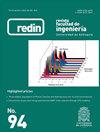Simulation of methanol production from residual biomasses in a Cu/ZnO/Al2O3 packed bed reactor
IF 0.5
Q3 ENGINEERING, MULTIDISCIPLINARY
Revista Facultad De Ingenieria-universidad De Antioquia
Pub Date : 2020-09-23
DOI:10.17533/UDEA.REDIN.20200907
引用次数: 2
Abstract
This article aims to simulate an algorithm constructed in MATLAB to represent the catalytic conversion of SYNGAS into methanol in a packed-bed reactor, based on chemical kinetics for a heterogeneous system with a Cu/ZnO/Al2O3 as a catalyst, and complementary math and phenomenological models, as a pressure drop and catalyst deactivation. Model validation is developed, comparing reference results and the results by running the algorithm in MATLAB using a reference SYNGAS composition. Also, the constructed model considers a catalyst deactivation by sintering and pressure drop along the reactor. Several parameters were evaluated to identify the pro conditions for methyl alcohol production; these parameters include the gasifying agent selection, the biomass and steam ratio effect, and the biomass origin. RESUMEN: El objetivo de este artículo es simular un algoritmo construido en MATLAB para representar la conversión catalítica de SYNGAS en metanol en un reactor de lecho empaquetado, basados en la cinética química para un sistema heterogéneo con un Cu/ZnO/Al2O3 como catalizador, y en modelos matemáticos y fenomenológicos, como caída de presión y desactivación del catalizador. Se realiza una validación del modelo, comparando los resultados de referencia y los resultados obtenidos al ejecutar en el algoritmo MATLAB la composición de referencia SYNGAS. Además, el modelo construido considera una desactivación del catalizador por sinterización y caída de presión a lo largo del reactor. Se evaluaron varios parámetros para identificar las condiciones para la producción de alcohol metílico; Estos parámetros incluyen la selección del agente gasificante, el efecto de la relación de biomasa y vapor y el origen de la biomasa. C. E. Artistizábal, A. F. Vargas and P. N. Alvarado. ”Simulation of methanol production from residual biomasses in a Cu/ZnO/Al2O3 packed bed reactor”, Revista Facultad de Ingeniería Universidad de Antioquia, no. 102, pp. 115-124, Jan-Mar 2022. [Online]. Available: https: //www.doi.org/10.17533/ udea.redin.20200907 ARTICLE INFO: Received: November 28, 2019 Accepted: September 23, 2020 Available online: September 23, 2020Cu/ZnO/Al2O3填充床反应器中残余生物质制甲醇的模拟
本文旨在基于Cu/ZnO/Al2O3为催化剂的非均相体系的化学动力学,以及作为压降和催化剂失活的互补数学和现象学模型,模拟在MATLAB中构建的算法,以表示在填充床反应器中SYNGAS催化转化为甲醇的过程。进行了模型验证,将参考结果与参考SYNGAS组合物在MATLAB中运行算法的结果进行了比较。此外,所构建的模型考虑了催化剂的烧结失活和沿反应器的压降。对几个参数进行了评估,以确定甲醇生产的有利条件;这些参数包括气化剂的选择、生物质与蒸汽比效应以及生物质来源。简历:在MATLAB中构建的模拟算法artículo代表了la conversión catalítica de SYNGAS en甲醇en反应器de leco empaquetado, basados en la cinsamettica química para un sistema heterogsamneo con Cu/ZnO/Al2O3 como催化剂,en modelos matemáticos y fenomenológicos, como caída de presión y desactivación del catalador。本文实现了una validación模型模型,比较了lo结果与lo结果与lo结果与lo结果之间的关系,并采用MATLAB算法与composición参考SYNGAS。Además, el modelo construcido considera una desactivación del catalador psinterización y caída de presión a lo large del reactor。不同的评估parámetros段相同的条件段producción de alcohol metílico;Estos parámetros包括la selección del agentente gasificante, el effecto de la relación de biomasa y vapor和el origen de la biomasa。C. E. Artistizábal, A. F. Vargas和P. N. Alvarado "Cu/ZnO/Al2O3填充床反应器中残余生物质制甲醇的模拟”,revsta学院Ingeniería Antioquia大学,no. 1。102,第115-124页,2022年1 - 3月。(在线)。可获取路径:https: //www.doi.org/10.17533/ udea.redin.20200907文章信息:收稿日期:2019年11月28日收稿日期:2020年9月23日在线发表日期:2020年9月23日
本文章由计算机程序翻译,如有差异,请以英文原文为准。
求助全文
约1分钟内获得全文
求助全文
来源期刊
CiteScore
2.00
自引率
0.00%
发文量
27
审稿时长
2 months
期刊介绍:
Revista Facultad de Ingenieria started in 1984 and is a publication of the School of Engineering at the University of Antioquia.
The main objective of the journal is to promote and stimulate the publishing of national and international scientific research results. The journal publishes original articles, resulting from scientific research, experimental and or simulation studies in engineering sciences, technology, and similar disciplines (Electronics, Telecommunications, Bioengineering, Biotechnology, Electrical, Computer Science, Mechanical, Chemical, Environmental, Materials, Sanitary, Civil and Industrial Engineering).
In exceptional cases, the journal will publish insightful articles related to current important subjects, or revision articles representing a significant contribution to the contextualization of the state of the art in a known relevant topic. Case reports will only be published when those cases are related to studies in which the validity of a methodology is being proven for the first time, or when a significant contribution to the knowledge of an unexplored system can be proven.
All published articles have undergone a peer review process, carried out by experts recognized for their knowledge and contributions to the relevant field.
To adapt the Journal to international standards and to promote the visibility of the published articles; and therefore, to have a greater impact in the global academic community, after November 1st 2013, the journal will accept only manuscripts written in English for reviewing and publication.
Revista Facultad de Ingeniería –redin is entirely financed by University of Antioquia
Since 2015, every article accepted for publication in the journal is assigned a DOI number.

 求助内容:
求助内容: 应助结果提醒方式:
应助结果提醒方式:


